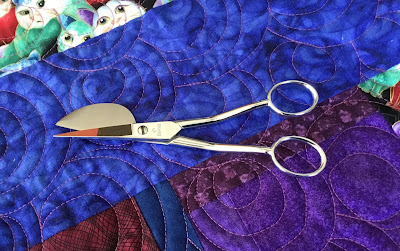This month, my guild, the
Choo Choo Quilters, had a program about adopting and embracing orphan blocks and ideas for using them in projects.
Orphan blocks—we all have them. They're tucked away in drawers, bags and boxes in the sewing room, they're the test blocks made before deciding to make a full quilt, the blocks from a class you took 5... 10... or 15 years ago, or maybe you rescued someone else's quilt blocks or vintage quilt top at a yard sale or e-Bay. Sadly, many of us have those lonesome misfits that never quite made it into a finished project.
 |
| One block Zippy Pouch made with an orphan quilt block. |
As I have "collected" quite a number of miscellaneous quilt blocks and rescued and repurposed several abandoned quilt tops over the years, I offered to help with the program. While gathering my examples, this lonely block resurfaced. I decided to give the re-purposing process a go and make this orphan into a useful item—a zippered pouch. A zippered project bag also happens to be one of my
Make Nine Challenge projects.
Serendipity! I got twice the bang from this one block.
Repurposing an orphan block
The pattern I used was the
Chunky Wee Zippy Pouch by
Sam Hunter of Hunter's Design Studio. This is a great pattern as it not only has instructions for three sizes and shapes (see photo above), but provides a formula for making a custom size. (Visit your local quilt shop and ask for this pattern or support the indie pattern designer and purchase from
her website.)
The size of my orphan block was 12.5" unfinished. Here is the quilted sandwich.
 |
| Quilted orphan block for zippered pouch. |
The backing—which ends up being the inside of the pouch—was another random fabric bit from my stash.
 |
Quilted block (inside). Examples of different free-motion fillers, a zigzag
and using rulers to stitch in the ditch can be seen. |
A single fold binding was attached in preparation for sewing in the zipper.
 |
| Orphan block quilted, trimmed and ready for zipper insertion. |
In addition to the orphan block, the materials used in the project were all scraps.
 |
| Finished zipper pouch. |
Benefits of creating with orphan blocks
As I worked through this project, I was reminded of several benefits to using these orphan UFOs [unfinished objects] in a project.
- you get a jump-start to making a project. Part of the work is already done! (by you or by someone)
- a small project offers an opportunity to practice free-motion quilting.
- it offers an opportunity to experiment with different FMQ designs. Try a different motif in each section of the patchwork.
- you can practice new quilting techniques: rulerwork, quilting in the ditch, walking-foot quilting, etc.
- this project gave me practice with inserting a zipper.
- a single orphan block can be combined with other orphan blocks, and/or combined with scraps from other projects.
- If your orphan is a rescue, it's fun to collaborate with other (anonymous) quilters.
- It's rewarding to recycle and give a new purpose and meaning to a languishing block or blocks.
 |
| Finished Zippy Pouch made from a single 12" quilt block. |
It was fun to refashion an unused quilt block into something new and useful. Several guild members showed examples of pillows, tote bags, needle books, and the like that they created from orphan quilt blocks and fabric bits. Put on your thinking cap and you will be pleasantly surprised.


























